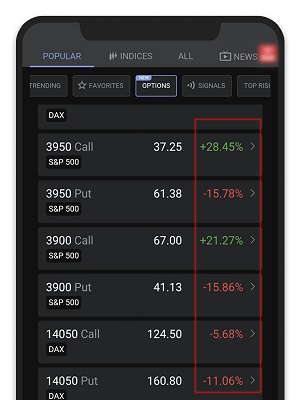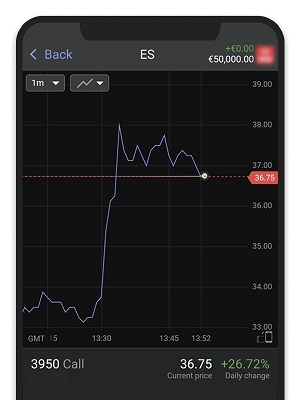

Why should I trade options CFDs?
Magnify volatility
The main advantage of trading options CFDs relative to the underlying asset is that they offer higher volatility and thus, a higher profit potential at a higher risk. The options pricing model works so that the change in the price of the underlying asset is multiplied when calculating the option’s value. This results in far more substantial price swings in the value of the option compared to the underlying asset.

Much higher volatility on Options CFDs compared with the underlying asset.
In the example above, you can see that the S&P 500 index is up 2.53% for the month and 15.86% for the year. Notably, the corresponding values for the S&P 500|Call 3550|Dec option CFD are 88.14% and 956.74%, which translates to approximately a price change that is 35 and 60 times greater, respectively.
Greater exposure
Additionally, options CFDs allow you to initiate larger positions with the same initial capital. This is possible because options’ prices tend to be substantially lower than those of the underlying asset. For example, a call option on the S&P 500 index may cost between $150 and $300, while the index itself trades around $3,000. Essentially, you could be trading price changes in the S&P 500 by investing as little as 5-10% of its actual cost.
Example
Looking at the S&P 500 again, let’s say that you think it’ll go up. If you were to buy one unit of it directly for $3,000, and it goes up to $3,500, you would make $500 (minus transaction fees) if you close your position. This equates to $500 profit with a $3,000 investment or (500/3000) * 100 = 16.7% return.
Now, let’s imagine that you invested the same amount to buy 20 Call option CFDs on the S&P 500 index, each costing $150, for a total of $3,000. The same change in the S&P 500 from $3,000 to $3,500 can easily increase the price of the options CFDs 4 to 6 times. But let’s be conservative and assume the price of the options only increases 3 times. In this scenario, if you were to close your position and sell your 20 Call option CFDs at the new price of $450 (3 x $150), you would get $9000 (20 x $450) (minus transaction fees). Therefore, you would have realised a $6,000 profit with the same $3,000 investment for a (6000/3000) * 100 = 200% return.
This example demonstrates how you could generate a rate of return approximately 12 times higher by using options CFDs instead of investing directly in the index. The caveat, of course, is that you are also assuming a higher risk. In the above example, if the S&P 500 had declined from $3,000 to $2,500 when you decided to close your position, you would have lost only $500 if you had invested in the index directly. However, if the S&P 500 had declined to $2,500 and didn’t recover before the expiration of the underlying option, the value of your option CFD could have declined to 0 if its strike price is lower than the current market price of the S&P 500. In this scenario, you would have lost your entire investment.

S&P 500|Call 3550|Dec was up 822% within the past three months while the S&P 500 index was up 8.4%. The potential gain from owning the Option CFD, in that case, was 100 times higher.
However, it is important to keep in mind that trading options CFDs enables you to magnify your potential profit at the expense of much higher risk. Therefore, it is advisable to invest only an amount that you are willing to risk and manage your risk by using an appropriate Stop Loss level.
Avoid some costs
Importantly, when trading options CFDs, you are not using overnight swaps. This reduces your overall trading costs and could be particularly important in mid- to long-term trading performance.
Now that you have an understanding of the rationale for using options CFDs and their mechanics, it’s time to learn about some of the trading strategies you can use.
Disclaimer: The information in this article is not intended to be and does not constitute investment advice or any other form of advice or recommendation of any sort offered or endorsed by Libertex. Past performance does not guarantee future results.
Why trade with Libertex?
- Get access to a free demo account free of charge.
- Enjoy technical support from an operator 5 days a week, from 9 a.m. to 9 p.m. (Central European Standard Time).
- Use a multiplier of up to 1:30 (for retail clients).
- Operate on a platform for any device: Libertex and MetaTrader.